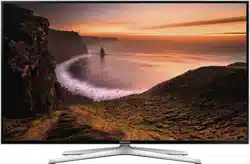Documents: Go to download!
- User Manual - (English)
- Samsung UA55H6400AW 55" 140cm Full HD Smart 3D LED LCD TV Multiroom Link Guide - (English)
User manual Tv
Quick Guide
Using the Smart TV
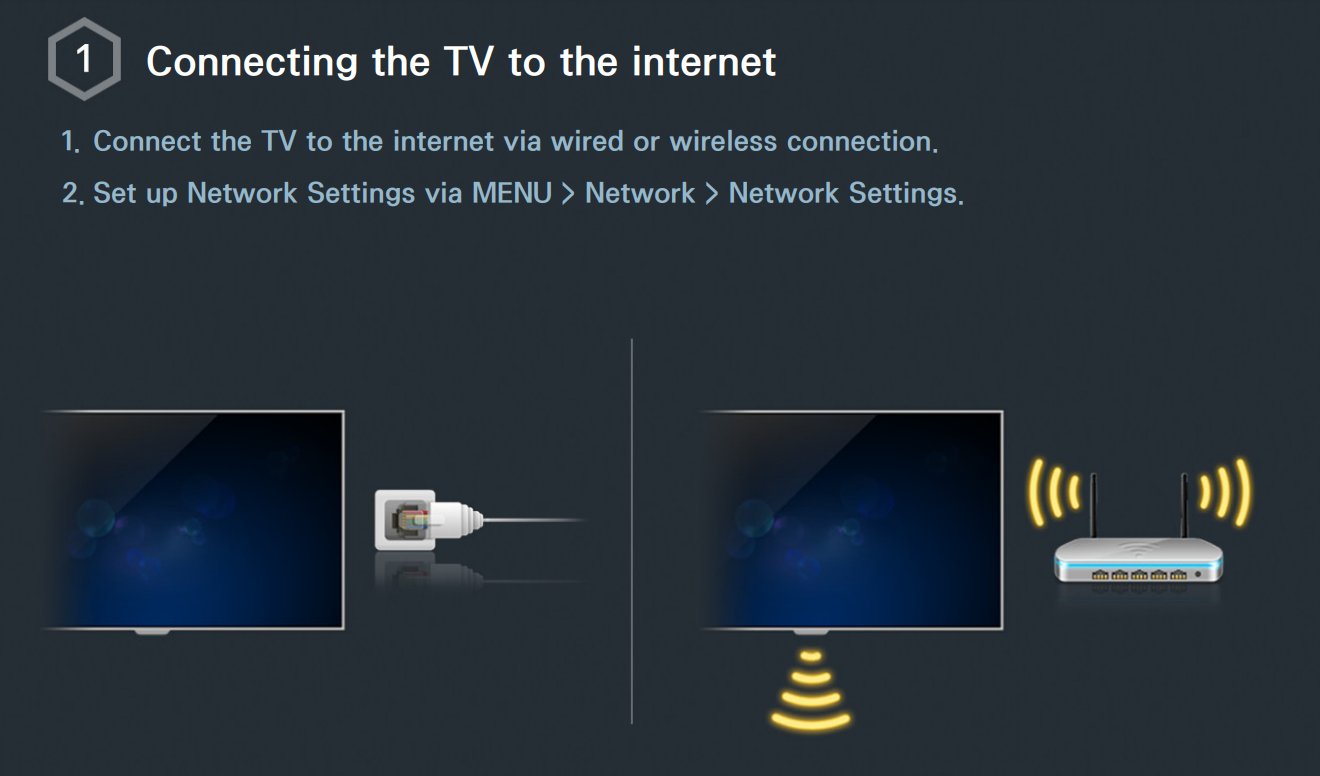
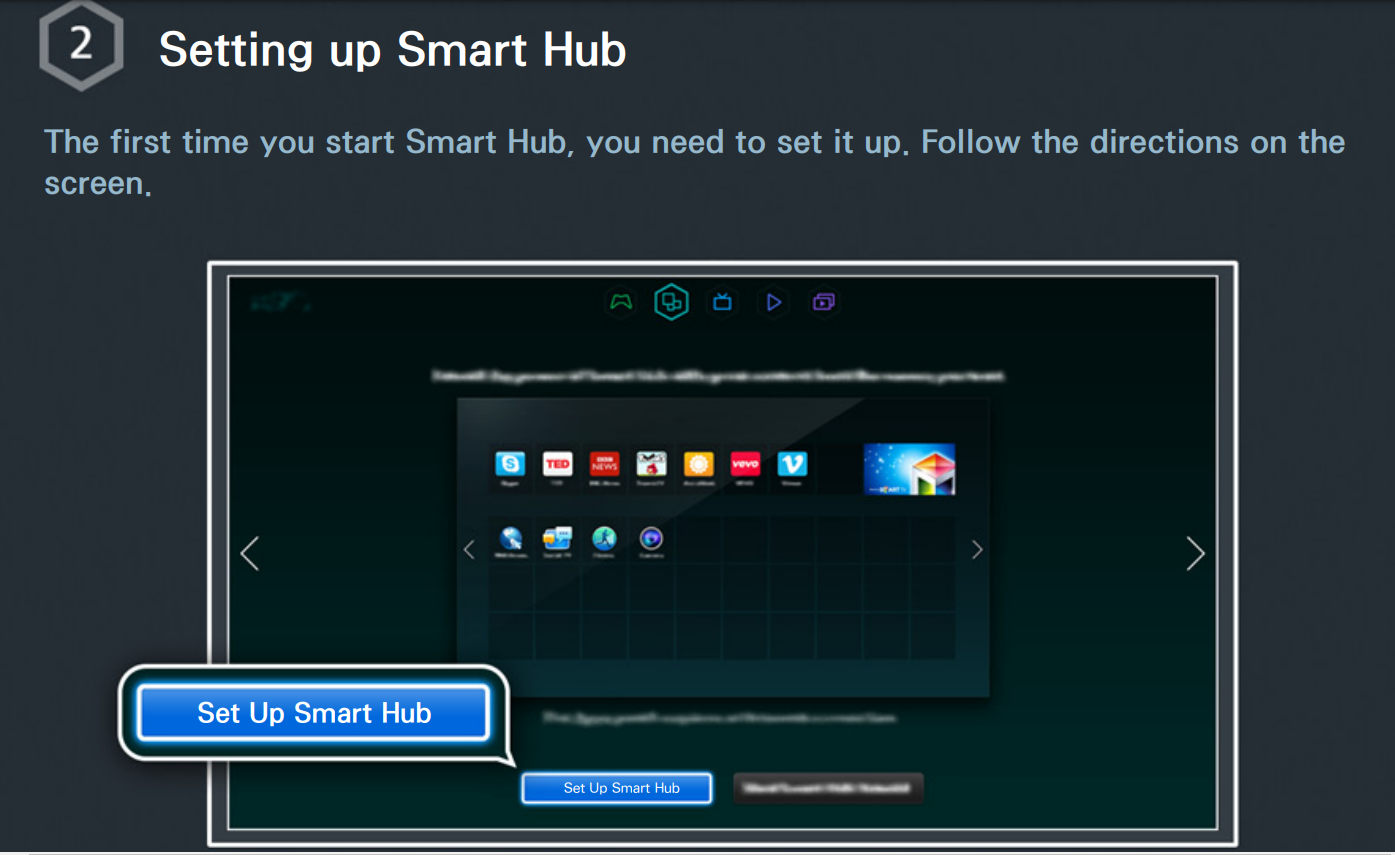

For more information, refer to "Smart Hub".
Using Voice Control
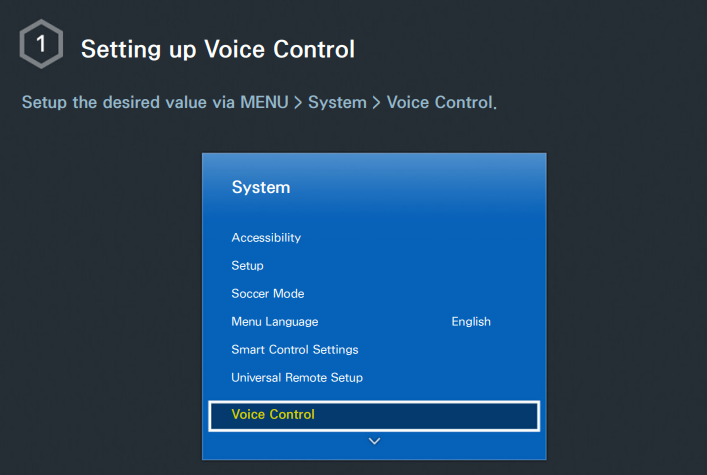
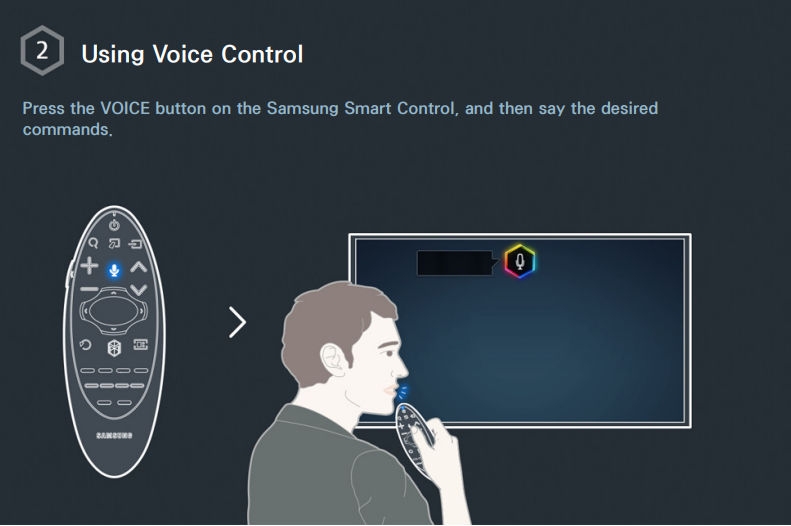
For more information, refer to "Controlling the TV with Your Voice (Voice Control)".
Using Motion Control

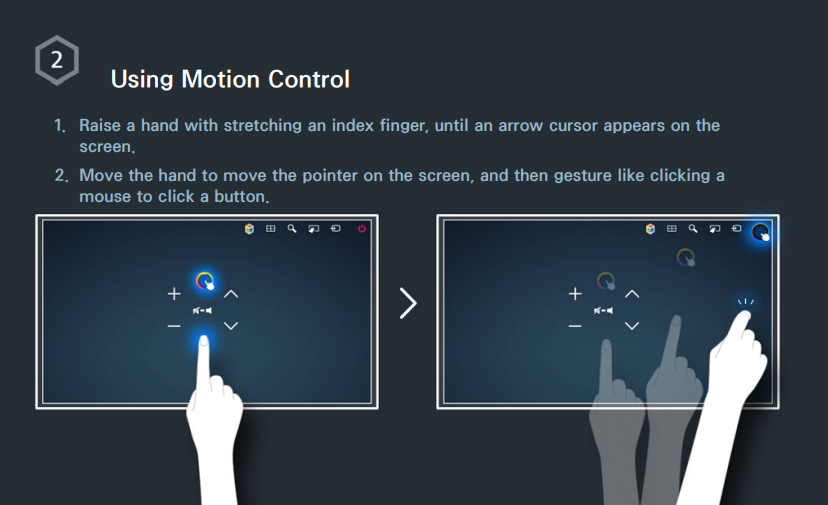
A TV camera (sold separately) needs to be connected in order to use Motion Control.
For more information, refer to "Controlling the TV using Motions (Motion Control)".
Connecting Antenna and External devices
Aerial Connection
- Before connecting any external devices and cables to the TV, first verify the model number. A sticker containing the model number is attached to the back of the TV. The connection method varies depending on the model.
- An aerial must be connected to the TV in order to receive broadcast signals.
- An aerial connection is not necessary when a cable box or satellite receiver is used.
- Connect the correct aerial cable according to your viewing environment to the TV's aerial connector, as shown in the diagram.

Video Device Connection
- Your TV has a variety of connectors for video input from external devices such as cable boxes, satellite receivers, Blu-ray players, DVD players, camcorders, and gaming consoles. Below is a list of featured connectors shown in descending order of picture quality.
- HDMI
- Component
- AV
- Connect a video device to the TV via an HDMI connector for the best picture quality. If the device does not have an HDMI connector, try a component connector to get the next best picture quality.
- The number of connectors and their names and locations may vary depending on the model.
- Refer to the external device's operating manual when connecting it to the TV. The number of external device connectors and their names and locations may vary depending on the manufacturer.
HDMI Connection
- Before connecting any external device or cable to the TV, first verify the TV's model number. A sticker containing the model number is attached to the back of the TV. The connection method varies depending on the model.
- The following types of HDMI cables are recommended:
- High-Speed HDMI Cable
- High-Speed HDMI Cable with Ethernet
- HDMI cables have certain requirements:
- Use an HDMI cable with a thickness of 14 mm or less.
- Using a non-certified HDMI cable may result in a blank screen or a connection error.
- Some HDMI cables and devices may not be compatible with the TV due to different HDMI specifications.
- This TV does not support HDMI Ethernet Channel. Ethernet is a LAN (Local Area Network) built with coaxial cables standardised by the IEEE.
- Refer to the diagram and connect the HDMI cable to the video device's HDMI output connector and the TV's HDMI input connector.
- The number of connectors and their names and locations may vary depending on the model.
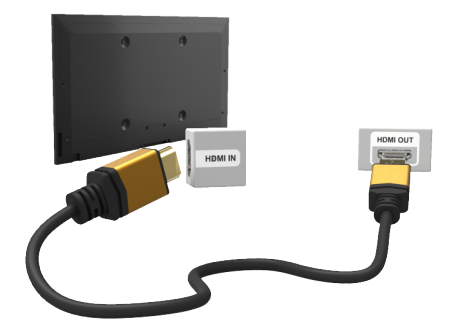
- Once the connection has been made, you will be able to select the connected external device using the SOURCE button.
Component Connection
- Before connecting any external devices and cables to the TV, first verify the model number of the TV you purchased. A sticker containing the model number is attached to the back of the TV. The connection method varies depending on the model.
- Refer to the diagram and connect the Component cable to the TV's component input connectors and the device's component output connectors.
- Make sure the cable colours match the connector colours.

- Once the connection has been made, you will be able to select the connected external device using the SOURCE button.
AV Connection
- Before connecting any external device or cable to the TV, first verify the TV's model number. A sticker containing the model number is attached to the back of the TV. The connection method varies depending on the model.
- Refer to the diagram and connect the AV cable to the TV's AV input connectors and the device's AV output connectors.
- If you are using the TV's AV input connectors, connect the video cable to the Y connector. Some models feature a video connector as well. In this case, connect the cable to the video connector.

- Once the connection has been made, you will be able to select the connected external device using the SOURCE button.
Smart Features
Using Multiple Functions in a Single Screen (Multi-Link Screen)
- Availability depends on the specific model.
This allows you to search the Web, use apps, and much more while watching TV.
- Before using Multi-Link Screen, make sure the TV is connected to the Internet. Using Multi-Link Screen requires an Internet connection.
- Before using Smart Hub with Multi-Link Screen, go to the On TV Settings (Smart Hub > On TV Settings > On TV Setup) and finish configuring Smart Hub. (Availability depends on the specific area.)
- If the Multi-Link Screen launches while the TV did not configure the Smart Hub, a pop-up window appears. To use the Multi-Link Screen, you need to configure the Smart Hub first. On the pop-up window, select the Set Up Smart Hub to finish configuring the Smart Hub. (Availability depends on the specific area.)
Launching Multi-Link Screen
- Picture > Open Multi-Link Screen
- From the Picture menu, select Open Multi-Link Screen. Press M.SCREEN on the Samsung Smart Control to launch Multi-Link Screen.
Using Multi-Link Screen
- UHD and FHD contents and channels cannot be viewed simultaneously.
- Launching Smart Hub while using Multi-Link Screen automatically terminates Multi-Link Screen.
- Certain TV features and apps may not be supported by Multi-Link Screen. If this is the case, exit from Multi-Link Screen and then use the feature.
Selecting a Feature
- Press the Samsung Smart Control's M.SCREEN button while Multi-Link Screen is running. The Options menu appears.
- Select a feature from the Options menu. This initializes the selected feature.
- Features supported by Multi-Link Screen vary depending on the country.
Changing the Channel/Volume
- Place the pointer or focus over the screen for which you want to change the channel or adjust the volume.
- Use the channel buttons to change the channel or the volume buttons to adjust the volume. This changes the selected screen's channel/volume.
Smart Hub
Smart Hub > Open Smart Hub Try Now
- With Smart Hub, you can surf the web, download apps, and stay in touch with family and friends through social networking services. In addition, you can use photo, video, and music files stored on external storage devices.
- Some Smart Hub services are paid services. To purchase such a service, the service provider account or Samsung Apps TV account (Samsung account) is required.
- Make sure the TV is connected to the Internet. The TV must be connected to the Internet in order to use Smart Hub.
- Some features of Smart Hub require an Internet connection and may not be available depending on the service provider, language, or region.
- To use Smart Hub, you must agree to the end user agreement and privacy policy. Otherwise, you will not be able to access the features and services related to them. You can view the entire content of the Terms & Policy by navigating to Smart Hub > Terms & Policy. If you don't wish to use Smart Hub anymore, you can withdraw the agreement. Try Now
Testing Smart Hub connections
- Support > Self Diagnosis > Smart Hub Connection Test
- If Smart Hub is not functioning, navigate to Support > Self Diagnosis > Smart Hub Connection Test.
- Diagnose the problem by checking the internet connection, your ISP, the Samsung server and the Samsung Apps panels.
- After completing the test, if Smart Hub continues to have problems, contact your Internet Service Provider or a Samsung Contact Centre.
Troubleshooting
Getting Support
The TV has several built-in systems designed for user and TV system support.
Support through Remote Management
Support > Remote Management Try Now
- If you need assistance with your TV, you can use this feature to let Samsung Electronics diagnose your TV remotely. You will need to read and agree to the service agreement before using this feature. A Samsung Electronics technician will then diagnose, repair, and update your TV remotely.
- This option requires an Internet connection.
What Does Remote Service Do?
Samsung Remote Support service offers you one-on-one support with a Samsung Technician who can remotely.
- Diagnose your TV
- Adjust the TV settings for you
- Perform a factory reset your TV
- Install recommended firmware updates
How Does it Work?
Having a Samsung Tech remotely service your TV is easy.

- Call the Samsung Contact Centre and ask for remote support.
- Open the menu on your TV and go to the Support section.
- Select Remote Management, and then read and agree to the service agreements. When the PIN screen appears, provide the PIN number to the agent.
- The agent accesses your TV.
Finding the Information You Need for Service
Support > Contact Samsung Try Now
- Use this option to find the support service website's address and contact number, your TV's model number, your TV's software version, the Smart Hub info, and other information you need to receive the service support.
- Press A to view the open source licence.
There is a problem with the screen.
Testing the Picture
Support > Self Diagnosis > Picture Test Try Now
- Before you review the list of problems and solutions below, run the Picture Test to determine if the problem is caused by the TV. The Picture Test displays a high definition picture you can examine for flaws or faults. If the test picture does not appear or there is noise or distortion, the TV may have a problem. Contact Samsung’s Call Centre for assistance. If the test picture is displayed properly, there may be a problem with an external device. Please check the connections. If the problem persists, check the signal strength or refer to the external device’s user manual.
- If the test picture does not appear or there is noise or distortion, the TV may have a problem. Contact Samsung’s Call Centre for assistance.
- If the test picture is displayed properly, there may be a problem with the external device. Please check the connections. If the problem persists, check the signal strength or refer to the external device’s user manual.
| The Problem | Try this! |
| Flickering and Dimming | If your Samsung Television is flickering or dimming sporadically, you may need to disable some of the energy efficiency features. Disable Energy Saving (System > Eco Solution > Energy Saving) or Eco Sensor (System > Eco Solution > Eco Sensor). |
| Component Connections/Screen Colour |
If the colour on your Samsung television screen is not correct or the black and white colours are off, run Picture Test (Support > Self Diagnosis > Picture Test). If the test results indicate that the problem is not caused by the TV, do the following:
|
| Screen Brightness |
If the colours on your Samsung TV are correct but just a little too dark or bright, try adjusting the following settings first.
|
| Motion Plus/Blur | If you notice ghosting or blurring on the screen, use the Motion Plus option (Picture > Picture Options > Motion Plus) to resolve the issue. |
| Unwanted Powering Off | If your Samsung TV appears to turn off by itself, try disabling some of the TV's energy efficiency features. See if Sleep Timer (System > Time > Sleep Timer) has been enabled. The Sleep Timer automatically turns the TV off after a specified period of time. If the Sleep Timer has not been enabled, see if No Signal Power Off (System > Eco Solution > No Signal Power Off) or Auto Power Off (System > Eco Solution > Auto Power Off) has been enabled and disable them. |
| Problems Powering On |
When the TV is turned on, the remote control receiver flashes 5 times before the screen turns on. If you are having problems powering on your Samsung television, there are a number of things to check before calling the service department. Confirm that the TV's power cord is connected correctly at both ends and that the remote control is operating normally. Make sure that the antenna cable or cable TV cable is firmly connected. If you have a cable/satellite box confirm that it is plugged in and turned on. |
| Unable to find a Channel | Launch Setup (System > Setup) or Auto Tuning (Broadcasting > Auto Tuning). If your TV is not connected to a cable box or satellite box, run Setup (System > Setup) or Auto Tuning (Broadcasting > Auto Tuning). |
| The TV image does not look as good as it did in the store. |
Store displays are all tuned to digital, HD (high definition) channels. If you have an analogue cable/set top box, upgrade to a digital set top box. Use HDMI or Component cables to deliver HD (high definition) picture quality. Many HD channels are upscaled from SD (Standard Definition) content. Look for a channel that is broadcasting true HD content.
Adjust the cable/satellite box's video output resolution to 1080i or 720p |
| The picture is distorted. |
The compression of video content may cause picture distortions, especially in fast moving pictures from sports programmes and action movies. A weak or bad quality signal can cause picture distortions. This is not an issue with the TV. Mobile phones used close to the TV (within 1 m) may cause noise in analogue and digital channels. |
| The colour is wrong or missing | If you’re using a Component connection, make sure that the Component cables are connected to the correct jacks. Incorrect or loose connections may cause colour problems or a blank screen. |
| The colour is poor or the picture is not bright enough. | Go to the Picture menu and then adjust the Picture Mode, Brightness, Sharpness, and Colour settings. See if Energy Saving (System > Eco Sensor > Energy Saving) has been enabled. Try resetting the picture. (Picture > Reset Picture) |
| There is a dotted line on the edge of the screen. | If the Picture Size has been set to Screen Fit, change the setting to 16:9. Change the cable/satellite box resolution. |
| The picture is black and white. | Make sure to properly connect any external device to the TV properly. |
| When changing channels, the picture freezes or is distorted or delayed. |
If the TV is connected to a cable box, try to reset the box. (Disconnect and then reconnect the AC cord and wait until the cable box reboots. It may take up to 20 minutes.) Set the output resolution of the cable box to 1080i or 720p. |
I can't hear the sound clearly.
Testing the Sound
Support > Self Diagnosis > Sound Test Try Now
Before you review the list of problems and solutions below, make sure that the Speaker Select menu item is set to TV Speaker, and then listen to the speakers again. If the TV still does not play audio, run the Sound Test. The Sound Test uses a built-in melody to check for sound problems. If the TV does not play sound during the Sound Test, or the sound is distorted, there may be a problem with the TV. Contact Samsung’s Call Centre for assistance. If the TV plays the Sound Test melody without distortion, there may be a problem with an external device. Please check the connections. If the problem persists, refer to the external device’s user manual.
- If you can't hear the melody or there is a problem, make sure Sound > Speaker Settings > TV Sound Output is set to TV Speaker and then try again. If the problem persists, there may be a problem with the TV. Contact Samsung’s Call Centre for assistance.
- If the melody is played, there may be a problem with the external device. Please check the connections. If the problem persists, refer to the external device’s user manual.
| The Problem | Try this! |
| There is no sound or the sound is too low at maximum volume. | Check the volume control of the device (cable/satellite box, DVD, Blu-ray, etc.) connected to your TV. |
| The picture is good but there is no sound. |
Set Sound > Speaker Settings > TV Sound Output to TV Speaker. If you are using an external device, check the device’s audio output option. (For example, you may need to change your cable box’s audio option to HDMI if the box connected to your TV is using an HDMI cable.) To listen to the computer sound, connect the external speaker to the computer’s audio output connector. Reboot the connected device by disconnecting and then reconnecting the device’ s power cable. |
| The speakers are making an odd sound. |
Make sure that the audio cable is connected to the correct audio output connector on the external device. For antenna or cable connections, check the signal information. A low signal level may cause sound distortions. Run Sound Test (Support > Self Diagnosis > Sound Test). |
I can't see 3D images clearly.
Testing 3D Picture Quality
Availability depends on the specific model.
Support > Self Diagnosis > 3D Picture Test
- If you have not paired your 3D glasses with the TV, pair them first. To test 3D picture quality, the TV and the 3D glasses must have been paired.
Put on the 3D glasses, navigate to Support > Self Diagnosis and select 3D Picture Test. The 3D Picture Test displays a high definition picture to examine the 3D screen for flaws or faults. If the test fails to identify a problem, there may be a problem with an external device or the signal strength.
- If the test picture does not appear or there is noise or distortion, the TV may have a problem. Contact Samsung’s Call Centre for assistance.
- If the test picture is displayed properly, there may be a problem with the external device. Please check the connections. If the problem persists, check the signal strength or refer to the external device’s user manual.
| The Problem | Try this! |
| The 3D glasses are not working correctly |
Make sure the glasses are powered on. The 3D feature may not work properly if there is another 3D product or an electronic device running nearby. If there is a problem, keep other electronic devices as far away as possible from the 3D Active Glasses. |
| I can't see 3D images clearly. |
The ideal viewing distance is three times or more the height of the screen. We also recommend watching 3D content with your eyes level with the screen. |
| The batteries in the 3D glasses are flat. | Turn off the 3D glasses when they are not in use. If you leave the 3D glasses on, the battery lifespan is shortened. |
There is a problem with the broadcast.
| The Problem | Try this! |
| The TV is not receiving all channels |
If your TV is not connected to a cable box or satellite box:
|
| There are no captions with digital channels. | Go to Subtitle (System > Accessibility > Subtitle) and change the Subtitle Mode. Some channels may not have caption data. |
| The picture is distorted. |
The compression of the video content may cause picture distortions. This is especially true with fast moving pictures from sports programmes and action movies. A weak signal can cause picture distortions. This is not a problem with the TV. |
The computer won't connect.
| The Problem | Try this! |
| The "Mode Not Supported" message appears. | Set your PC’s output resolution so it matches a resolution supported by the TV. |
| The video is OK but there is no audio. |
If you are using an HDMI connection, check the audio output setting on your PC. If you are using a DVI to HDMI cable, a separate audio cable is required. |
I can't connect to the Internet.
| The Problem | Try this! |
| The wireless network connection failed. | Make sure the TV is connected to a wireless IP router. |
| The software update over the Internet has failed |
Check the network connection status. If the TV is not connected to a network, connect to a network. The upgrade stops if you already have the latest software version. |
The Schedule Recording/Timeshift function isn't working.
| The Problem | Try this! |
| The TV cannot recognise the USB device or the Format Device, Check Device and Device Performance Test functions fail. |
Refer to the USB device's manual and see if data can be stored on it. Check if the USB device is in a locked state. Check if the USB device was formatted when it was connected to a computer. Formatting a USB device after connecting it to the TV may result in a formatting failure. If Device Performance Test or Format Device has failed, there may be a problem with the USB device or its specifications. Try using a different USB device |
| There is a message saying I need to format the USB Drive. |
Check if the USB device is in a locked state. Use the USB recovery function to recover the USB device |
| Schedule Recording cannot be used. | Check if there is a USB device connected to the TV. Check if the channel is a digital channel that can be recorded. Recording will automatically stop if the signal becomes too weak. The Timeshift function will not work if there isn't enough storage space on the USB device. |
| I get a performance test failure message and then Schedule Recording and the Timeshift operation stops working | This problem can occur when using a low-performance USB Drive that does not support recording. A USB hard drive with a speed of 5,400rpm or above is recommended. A USB memory stick is not supported. |
Anynet+ (HDMI-CEC) isn't working.
| The Problem | Try this! |
| Anynet+ does not work. |
Confirm that the device is an Anynet+ device. The Anynet+ system supports Anynet+ devices only. Check if the power cord of the Anynet+ device is properly connected. Check the cable connections of the Anynet+ device. Go to System and see if Anynet+ (HDMI-CEC) has been set to On. Check whether the TV remote control is in TV mode. Check whether the remote control is Anynet+ compatible. Anynet+ may not function when certain functions are operational. (Channel Search, Smart Hub, set up, etc.) If you have disconnected and then reconnected the HDMI cable, scan for devices again or turn your TV off and on. |
| I want to start Anynet+. |
Check if the Anynet+ device is properly connected to the TV and then navigate to the System menu to see if Anynet+ (HDMI-CEC) is set to On. Once verified, select TOOLS button. A list appears. Select Anynet+ (HDMI-CEC) from the list and then a device. |
| I want to exit Anynet+. |
Select View TV from the Anynet+ menu. Select a non-Anynet+ device from the Source list.. |
| The message "Connecting to Anynet+ device..." or "Disconnecting from Anynet+ device" appears on the screen. | You cannot use the remote control when you are configuring Anynet+ or switching to a viewing mode. Use the remote control after the TV has completed the Anynet+ configuration or has switched to a viewing mode. |
| The Anynet+ device won't play | You cannot use the play function when Setup is in progress. |
| The connected device is not displayed.The TV audio is not being played through the receiver |
Check whether the device supports Anynet+. Check whether the HDMI cable is properly connected. Go to System and see if Anynet+ (HDMI-CEC) has been set to On. Scan for Anynet+ devices again. Anynet+ devices must be connected to the TV using an HDMI cable. Make sure the device is connected to your TV with an HDMI cable. Some HDMI cables may not support Anynet+. If the connection is terminated because there has been a power failure or the HDMI cable has been disconnected, please scan for the device again. |
| The TV audio is not being played through the receiver. |
Connect an optical cable to the TV and the receiver. ARC enables digital sound to be outputted via the HDMI (ARC) port. However, ARC is only available when the TV is connected to an audio receiver that supports ARC. |
I am having trouble launching/using apps.
| The Problem | Try this! |
| I launched an app, but it's in English. How can I change the language? | Languages supported by the app may be different from the user interface language. The ability to change the language depends on the service provider. |
| My application is not working. |
Check with the service provider. Refer to the help section on the application service provider's website. |
My file won't play.
| The Problem | Try this! |
| Some files can't be played. | This problem may occur with high-bitrate files. Most files can be played back, but you might experience problems with high-bitrate files. |
I want to reset the TV.
| The Problem | Try this! | Description |
| Reset Settings | Support > Self Diagnosis > Reset | Reset Picture, Sound, Channel, Smart Hub, and all other settings except for the network settings to their factory default settings |
| Resetting Smart Hub |
Smart Hub > Reset Smart Hub |
Reset all saved information relating to Samsung accounts and linked service accounts, as well as Smart Hub service agreements and applications. |
Other Issues
| The Problem | Try this! |
| The TV is hot. | Watching TV for an extended period of time causes the panel to generate heat. The heat from the panel is dissipated through internal vents running along the top of the TV. The bottom, however, may feel hot to the touch after extended use. Children watching TV need constant adult supervision to prevent them from touching the TV. This heat, however, is not a defect and does not affect the TV's functionality. |
| The picture won’t display in full screen |
HD channels will have black bars on either side of the screen when displaying upscaled SD (4:3) content. Black bars will appear at the top and bottom of the screen when you watch movies that have aspect ratios different from your TV. Adjust the picture size options on your external device or set the TV to full screen. |
| The "Mode Not Supported" message appears | The output resolution of the attached device is not supported by the TV. Check the supported resolutions of the TV and adjust the external device’s output resolution accordingly. |
| The Subtitle item in the TV menu is grayed out. | You cannot select the Subtitle menu if you have selected a source connected to the TV via HDMI or Component connections. To view subtitle, turn on the external device's subtitle function. |
| The TV smells of plastic | This smell is normal and will dissipate over time. |
| The Signal Information option under Self Diagnosis isn't activated. | Verify that the current channel is a digital channel. The Signal Information is only available for digital channels. |
| The TV is tilted to the side. | Remove the base stand from the TV and reassemble it. |
| The Broadcasting option has been deactivated. |
Broadcasting is only available when the Source is set to TV. The Broadcasting menu cannot be accessed while watching TV using a cable box or satellite receiver. Certain Broadcasting menus cannot be accessed while recording or while the TimeShift operation is in progress. |
| The settings are lost after 30 minutes or every time the TV is turned off. |
If the Use Mode is set to Store Demo, the TV's audio and video settings are automatically reset every 30 minutes. Change the Use Mode (Support > Use Mode) to Home Use. |
| There is an intermittent loss of audio or video. |
Check the cable connections and reconnect them. Loss of audio or video can be caused by using overly rigid or thick cables. Make sure the cables are flexible enough for long term use. If you are mounting the TV to a wall, we recommend using cables with 90-degree connectors. |
| There are small particles on the TV's bezel. | This is part of the product’s design and is not a defect |
| The PIP menu is not available. | PIP functionality is only available when you are using an HDMI or Component source. |
| A POP (TV’s internal banner ad) appears on the screen | Change the Use Mode (Support > Use Mode) to Home Use. |
| The TV is making a popping noise. | The expansion and contraction of the TV's outer casing may cause a popping noise. This does not indicate a product malfunction. The TV is safe to use. |
| The TV is making a humming noise. |
Your TV utilizes high-speed switching circuits and high levels of electrical current. Depending on the TV's brightness level, the TV may seem slightly noisier than a conventional TV. Your TV has undergone strict quality control procedures that meet our demanding performance and reliability requirements. Some noise coming from the TV is considered normal and is not an acceptable cause for an exchange or refund. |
Before Using the Recording and Timeshift Functions
Availability depends on the specific model and area.
Before Using the Recording and Schedule Recording Functions
- To set up a Schedule Recording, you must first set the TV's clock. Set the Clock (System > Time > Clock).
- Recordings are DRM-protected and therefore cannot be played back on a computer or on a different TV. In addition, these files cannot be played back on your TV if its video circuit has been replaced.
- A USB hard drive with a speed of 5,400rpm or above is recommended. However, RAID-type USB hard drives are not supported.
- USB memory sticks are not supported.
- The total recording capacity may vary depending on the amount of available hard drive space and the recording quality level.
- Schedule Recording requires at least 100MB of free space on the USB storage device. Recording will stop if the available storage space falls below 50MB while recording is in progress. If the available storage space falls below 500MB while both the Schedule Recording and Timeshift functions are in progress, only the recording will stop.
- The maximum recording time is 360 minutes.
- A video is played according to the TV settings.
- If the input signal is changed while recording is in progress, the screen will go blank until the change is made. In this case, recording will resume, but
 will not be available.
will not be available. - Device Performance Test must be performed on the USB storage device connected to the TV before a recording can be made. To perform the Device Performance Test, select Recorded TV in the On TV panel or USB Drive in the MULTIMEDIA panel and then select the recording device. When you make a recording on the Guide or Programme Info screen, if the USB storage device has failed in the Device Performance Test, the Format Device and Device Performance Test are performed again.
- When using the Record or Schedule Recording function, the actual recording may start a second or two later than the specified time.
- If the Schedule Recording function is operating while a recording is being made on an HDMI-CEC external device, the priority is given to the Schedule Recording.
- Connecting a recording device to the TV automatically deletes abnormally saved recording files.
- If the Off Timer or Auto Power Off has been set, the TV will overide these settings, continue to record, and turn off after the recording has ended.
Before the Using Timeshift Function
- A USB hard drive with a speed of 5,400rpm or above is recommended. However, RAID-type USB hard drives are not supported.
- USB memory sticks or flash drives are not supported.
- The total recording capacity may vary depending on the amount of available hard drive space and the recording quality level.
- If the available storage space falls below 500MB while both the Schedule Recording and Timeshift functions are in progress, only the recording will stop.
- The maximum amount of time available for the Timeshift function is 90 minutes.
- The Timeshift function is not available for locked channels
- A time-shifted video is played according to the TV settings.
- Before the Timeshift function can be used, the Device Performance Test must be performed on the USB storage device connected to the TV. To perform the Device Performance Test, select Recorded TV in the On TV panel or USB Drive in the MULTIMEDIA panel and then select the recording device.
- The Timeshift function may be terminated automatically once it reaches its maximum capacity.
- The Timeshift function requires at least 1.5GB of free space available on the USB storage device.
- Launching an app, switching to an analogue channel, or changing the TV to a mode that does not support the Timeshift function automatically terminates the Timeshift function. The Timeshift operation will resume if the TV is changed back to a digital channel again.
Before Using 3D Viewing Mode
3D Precautions
Warning
- In 3D viewing mode, the screen may flicker under florescent lighting (50Hz ~ 60Hz) or three-wave lighting.
- If this occurs, turn off the lighting or adjust it to a low level.
- When you switch the picture mode from 3D view, the 3D view mode turns off, and the 3D glasses no longer provide a 3D view.
- When you turn off 3D mode, the 3D glasses also turn off in a few moments.
- If you are watching TV with 3D glasses and you lie on your side, the picture may look darker or may not be visible.
- If the 3D glasses are defective or damaged, they cannot be repaired and need to be exchanged for a new pair. The repair service is free of charge within the warranty period. Note that the warranty does not cover damage caused by the user.
- The actual 3D effect may be experienced differently depending on the viewer. The 3D effect may not be experienced by persons who has a large difference of vision between the left and right eyes.
- In 3D viewing mode, watch TV within the recommended distance.
- The 3D functionality of the glasses may not work properly if you move out of the recommended range for about 3 seconds or more.
- If you stay outside the recommended range, the 3D glasses lose wireless wireless communications with the TV. If this occurs, the 3D display turns off and, a few seconds later the glasses turn off.
- The 3D glasses may not work properly if there are any nearby active 3D devices or electronic or wireless communication devices (for example, a device that uses the 2.4GHz frequency range such as a microwave or AP). If this occurs, move the devices away from the 3D glasses.
- The Samsung Multi View 3D Glasses may not work properly near metal objects or near an electromagnetic field. If this occurs, move the metal objects or the electromagnetic device away from the 3D glasses.
- The vividness of the image may degraded if you watch a 3D movie in a location exposed to direct sunlight or illumination.
- The temples of the 3D glasses do not fold. Do not attempt to fold the temples. You can damage the 3D glasses.
- When watching 3D content for an extended period of time without averting your eyes, the 3D glasses may turn off automatically (applicable to the SSG-3570 only).
- Take off the 3D glasses and put them on again if they do not work in 3D viewing mode first (applicable to the SSG-3570 only).
Caution: 3D Health and Safety Information Users are required to read the following information before using 3D.
- A supervising adult should check on any children watching 3D TV regularly. Children experiencing eye fatigue, headaches, dizziness, and/or nausea while viewing 3D TV should stop watching immediately.
- Do not use the 3D glasses for any purpose other than their intended purpose. Do not use them as general eyeglasses, sunglasses, or protective goggles.
- Some users may feel dizzy, nauseous, or experience headaches in the 3D or Samsung Multi View function. If you experience any of these symptoms, stop watching the 3D item, remove the 3D glasses, and rest.
- An extended period of watching TV in 3D viewing mode may cause eye fatigue. In this case, stop watching 3D immediately, take off the 3D glasses, and allow your eyes to rest.
- Do not use the 3D function or 3D glasses while walking or moving around. Using 3D mode or wearing 3D glasses while moving around may result in injury due to walking into objects, tripping and/or falling.
- Wearing the 3D glasses and lying on your side while watching TV may damage the temples of the 3D glasses.
- The temples of the 3D glasses are unfolded. This may damage the 3D glasses.
- Because the 3D glasses react to acceleration, repeatedly shaking the 3D glasses may consume the battery faster than normal (applicable to the SSG-3570 only
See other models: RF22M9581SR/AC UA32D4003 NE59R6631SG/AC SM-G986UZAECHA QE55LS01RBUXZG
